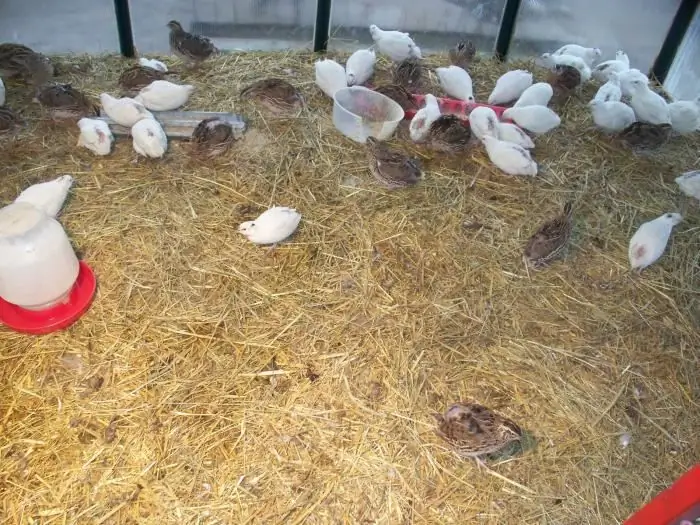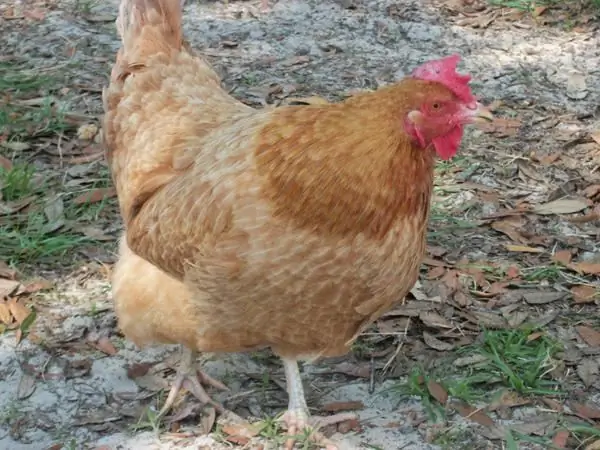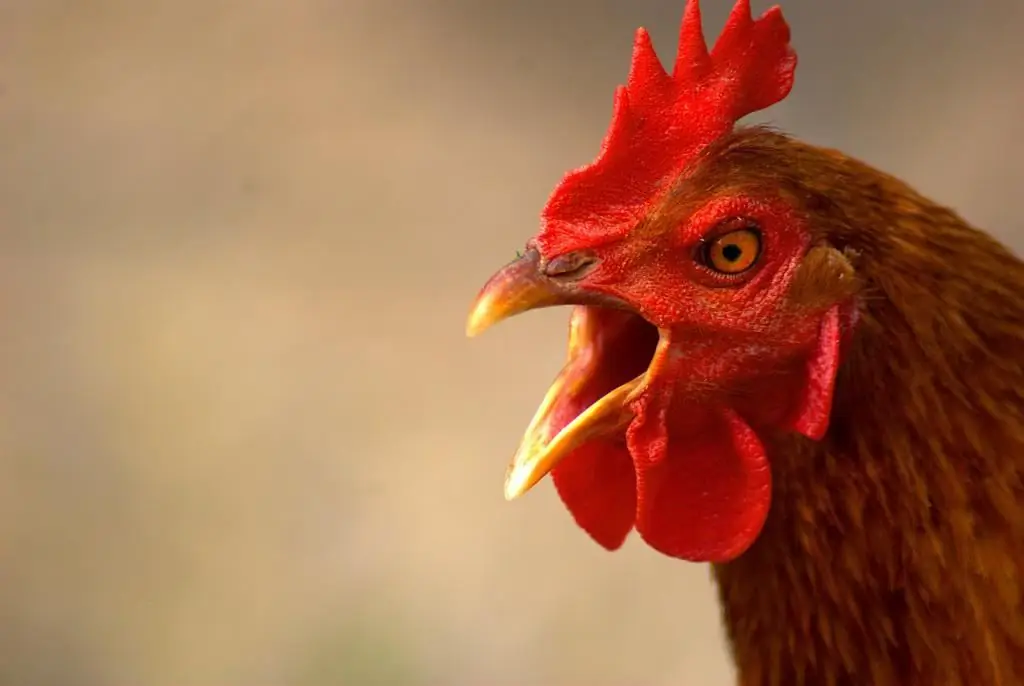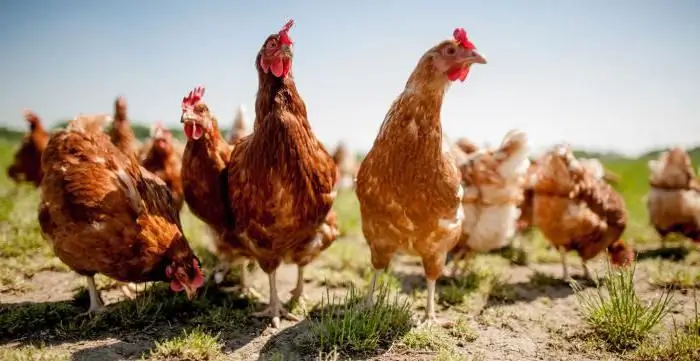2025 Author: Howard Calhoun | [email protected]. Last modified: 2025-01-24 13:10:45
In the feeding of any farm animals, including birds, one of the leading roles in increasing productivity belongs to feeding. Here will be considered recipes for compound feed for chickens. Any cross of the egg direction with improper feeding will not provide the egg production that is genetically inherent in it. Compound feed can be used ready-made, or you can make it yourself.
The concept of industrial feed

They are loose and granular. They are made for a specific type of bird, depending on its use, age and sex.
Often chicken feed is produced as a complete mixture. This indicates that only it can be used to feed this group of poultry, since it contains all the mineral elements, vitamins, necessary substances in the proportions that have been established by science and practice.
Assortment of industrial feed forthe bird in question is not very wide. So, for laying hens of the age of 20-44 weeks, PK-1-1 compound feed is produced, and for older ones - PK-1-3.
Regulatory requirements regulate not the composition of feed for chickens, but the energy nutritional value of the diet, its nutritional value, the absence of harmful impurities.
In most cases, the ingredients of PC-1-1 are as follows:
- wheat - 65%;
- sunflower meal - 18%;
- meat and bone meal - 11%;
- vegetable oil - 2.5%;
- feed yeast - 2%;
- vitamins and minerals supplements - 1.5%.
For those who feed the birds with different feeds, the industry produces grain mixtures that are used to balance diets.
The main advantages and disadvantages of industrial and domestic compound feeds
The main advantage of industrial compound feed for chickens is that the farmer or poultry breeder at home does not need to worry about how to balance the diet that the bird needs in a particular time period.
The disadvantages include the following:
- comparatively expensive way to feed;
- buying feed from an unknown manufacturer, the poultry farmer buys a “pig in a poke”: it is not known what antibiotics, dyes, preservatives were added to it, under what conditions it was stored, and therefore the question of the effect of eggs remains unclear obtained from a bird that received such compound feed for laying hens.
The concept of homemade feed

The digestive tract of a chicken is adapted for the consumption of various feeds, both vegetable and animal in nature. Basically, the diet is saturated with their concentrated varieties, made from the grain of the respective crops. In addition, homemade feed for chickens includes greens, fruits, and vegetables that have a reduced energy value compared to the above feeds.
Broilers and laying hens should get their own special diet. This is due to the fact that the first need to give out meat productivity, while the second needs to provide the appropriate egg production.
Therefore, the ratio in compound feed for chickens is considered optimal, which includes 80% concentrates and 20% voluminous feeds and those of animal origin. If it is impossible to provide such a quantity of grain mixtures, their specific gravity can be reduced to 65%.
Sometimes stirrers are prepared at home. With this method, concentrates and vegetables are seasoned with warm water or whey. In summer, it is enriched with vitamins and minerals, and in winter - with fish oil. They are used if the bird pecks food within an hour.
Using ingredients in self-made compound feed
During the implementation of this process, you need to carefully monitor that the components that make up the combined feed are of high quality. This must be done in order not to poison the bird.
As already noted, in the composition of compound feed for laying hens, theirhand-made should include concentrates, bulky foods, those of animal origin, as well as yeast and premixes that include various minerals and vitamins in their composition to support the optimal life of the bird.
Concentrates in the diet

These include the grains of the respective crops, which can be subjected to various processing, crushed or used as a whole:
- Proper grains (wheat, rye, barley, oats, corn). They are characterized by a large amount of easily digestible carbohydrates in their composition. In home cooking, it is better to use a mixture of flour from these grains and whole seeds. As for people, sprouted grains are of great benefit, due to the increased content of B vitamins in it.
- Beans (lupins, soybeans, peas, chickpeas, lentils, chickpeas) - contain a large amount of crude protein (in soy and lupine it can reach 40%).
- Oilseeds (colza, sunflower, rapeseed) - contain easily digestible fats and tocopherol. They are usually used in the form of meal or cake, which is a waste oil production.
When compiling compound feed recipes at home, one must proceed from the fact that it contains not one, but two or three concentrates. Usually the bird is fed corn, barley and wheat. If the farm has several grain feeds, then it is better to observe the chickens during the feeding period and identify the feed that is most readily consumed.
Vulkyfeed

Similar feed ingredients are divided into the following groups:
- Juicy (green grass, berries, fruits, vegetables). The source of carotene are vegetables that have an orange color (pumpkin, carrots), due to which the yolk of chicken eggs becomes a rich orange color.
- Coarse (hay dust, hay) - replace grass in the winter season. For the bird in question, the following herbs are dried: plantain, wood lice, couch grass, alfalfa, sainfoin, clover, nettle.
Various feed contains a large amount of vitamins, the amount of fiber, when properly balanced, does not exceed acceptable standards. When using them, laying hens do not gain excess weight.
Feed of animal origin
They are high in complete protein. These include:
- meat and fish offal;
- waste from the processing of meat and fish products;
- broths on meat or fish;
- dairy products (cottage cheese, whey, skim milk, milk of various freshness) containing calcium, which prevents the purchase of synthetic analogues of this element.
Meat giblets should be added in small quantities as they can adversely affect the he alth of the bird. Also don't go overboard with white bread and sweets for the same reasons.
Premixes for animal feed

Even with the right balance of the diet for the main substances, one feelslack of certain mineral elements and vitamins. Therefore, even in industrial, even in home mixed fodders, it is necessary to add vitamin and mineral supplements to them in the form of premixes. In your own household, if it is impossible to purchase the latter, you can use chalk and shell rock as a source of calcium, vitamin D - fish oil, tocopherol - sunflower oil.
Any compound feed should be moderately s alted. To do this, add 3-5 g of sodium chloride per 1 kg.
Using fodder yeast
They are used to increase the nutritional value and digestibility of other components. Do-it-yourself 1.5 l of a room temperature solution prepared with 20 g of yeast is added to 1 kg of compound feed for chickens prepared for this moment according to the recipe for chickens, after which they are mixed and kept in a warm place overnight.
Making compound feed at home

After the ingredients are selected, it is necessary to determine their percentages. To do this, balancing is carried out for each ingredient using special reference tables. Ready-made chicken feed should contain about 15-20% crude protein and no more than 6% fiber. In industrial conditions, balancing is carried out according to a variety of indicators. At home, at least these two can be considered.
Chickens prefer heated compound feed, but if this is not possible, then they use it, prepared by crushing individual grains mixed with whole ones. High humiditycomponents are included in the composition of the combined feed immediately before use, otherwise they may cause mold.
One hen consumes about 120 g of cooked mixture per day, with fluctuations from 75 to 150 g.
DIY compound feed recipes for laying hens
There are many variations of different formulations used in feeding the bird in question. Any of them are aimed at maintaining her he alth and increasing productivity.
Let's take a look at some of the recipes.
For 1 kg of compound feed, you can add the following ingredients (g):
- corn - 450;
- wheat - 120;
- barley - 70;
- meat and bone meal - 60;
- fish and herbal flour - 50 each;
- feed yeast - 40;
- sunflower meal - 70;
- bean component - 20;
- premix - 15;
- s alt - 1-3.
There is a similar recipe with the addition of various nutrients:
- corn - 450;
- wheat - 150;
- barley - 70;
- meat and bone meal - 50;
- fishmeal - 50;
- herbal flour - 30;
- feed yeast - 10;
- sunflower meal - 70;
- bean component - 20;
- premix - 10;
- eggshell or lump chalk - 10-20;
- sunflower oil - 3-4;
- s alt - 3.
This diet is fully balanced in terms of essential substances, vitamins, macro- and microelements, fiber.

In caseIf you need to add vegetables, the following recipe can be used (the amount is indicated in grams):
- wheat - 40;
- barley - 40;
- boiled potatoes - 70;
- fresh greens, vegetable tops, hay - 30-40;
- grated carrot - 20;
- wheat bran - 15;
- fish and meat waste - 10-15;
- s alt - 3.
Compound feed is better to try to make according to different recipes, watching the eating of each bird in question.
It must be remembered that it is impossible to radically correct egg production with one feeding. It is necessary to select the appropriate cross, take into account the season of the year and the microclimate in the room where they are kept.
In closing
Compound feed for chickens can be industrial and home-made. The first one already includes the optimal set of feeds for birds of a particular age. In the second, you yourself need to choose the components for optimal balancing. Any recipes must necessarily include concentrated foods as a source of carbohydrates and legumes as a protein ingredient. If necessary, vegetables, herbs, fruits, hay can be included in their composition. An orange yolk will be obtained by using vegetables rich in carotene or lupine, which contains a large amount of this substance.
Recommended:
Quail food: composition, norm, recipe and price. How to make quail food with your own hands?

Own home garden for many has become a symbol of their own vegetables and fruits, which allow you to diversify your table with fresh and environmentally friendly products. Some breed chickens, geese and ducks in order to provide themselves with meat
Faverol chickens. French breed of chickens

Modern farmers, engaged in subsistence farming, prefer to use breeds of universal orientation for breeding birds, providing the family with both meat and eggs in sufficient quantities. That is why breeding breeds of birds bred for this very purpose have recently become popular
Kuchinsky anniversary chickens. Meat chickens. Egg breeds of chickens

Poultry farming has been extremely popular with our peasants since ancient times. Chickens and ducks required little care, in the summer they found food on their own, and the eggs and meat received from them were a valuable source of protein, which was so necessary in a difficult rural lifestyle
Cannibalism in chickens: causes and treatment. Features of keeping chickens

Cannibalism in chickens is a rather creepy sight that can scare even an experienced farmer. Of course, this brings serious losses to any economy. Therefore, it is especially important to know how to act in such a situation in order to quickly solve the problem
Cross chickens. Growing chickens at home for beginners. Hybrid chicken breeds

Successful breeding of chickens of any kind depends on the right breed, conditions of detention, feeding, personal desire to breed poultry. One of the most popular breed groups are chicken crosses. These are poultry hybrids obtained by crossing different breeds. Such a process is complex and is carried out only by specialists according to strictly established rules

